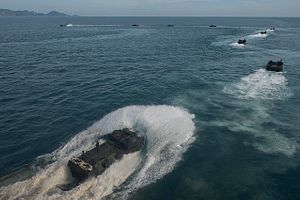Each year, for the last 20 years, U.S. Naval forces conduct an annual bilateral exercise series with their counterparts from several regional countries. Called Cooperation Afloat Readiness and Training (CARAT), this year’s evolution with Malaysia clearly reflected the growing relationship between the two militaries.
According to U.S. Navy Captain Fred Kacher, Deputy Commander of Destroyer Squadron Seven, CARAT is their premier exercise series in Southeast Asia, a region on the rise and one where the Navy expects to play a larger role in the future. This year’s iteration occurs shortly after the visit of President Barack Obama to Malaysia, where he and Prime Minister Najib Razak decided to elevate the U.S.-Malaysia relationship to the status of Comprehensive Partnership.
“The level of military-to-military cooperation is certainly one of the highlights of the U.S.-Malaysia bilateral relationship and hopefully, this will only improve and intensify qualitatively under the Comprehensive Partnership,” said Elina Noor, Assistant Director for Foreign Policy and Security Studies at Malaysia’s Institute of Strategic and International Studies.
Breadth and Depth
This years CARAT exercise got underway shortly after the search for the missing Malaysia Airlines Flight MH370. Malaysian Defence Minister Hishammuddin Tun Hussein thanked U.S. Secretary of Defense Chuck Hagel for his support when they met on the sidelines at the recent Shangri-La Dialogue in Singapore.
Hishammuddin was previously home affairs minister, which placed him in the middle of the combined law enforcement and military response to the Lahad Datu incident, where militant supporters of the Sulu Sultanate landed on Sabah from Tawi-Tawi in February 2013. Ultimately the militants were routed in a Malaysian response dubbed Operation Daulat. While plans for a marine force drawing on personnel from all three services of the Malaysian Armed Forces had been studied prior to the Lahad Datu incident, they took on greater urgency after the military operation to secure Sabah. In October 2013, Hishammuddin announced a proposed marine force that would focus on security in East Malaysia. He revealed that Malaysia would work with the U.S. Marine Corps in this effort. In an April 2014 speech in Washington D.C., Lieutenant General John Wissler, Commanding General of the Third Marine Expeditionary Force, said that as Malaysia moves ahead, the Marines “will be partnered with them as they build their marine corps.”
This partnership was on display during the amphibious phase of the exercise, when U.S. Marines embarked on the dock landing ship U.S.S Ashland (LSD 48), conducting a series of amphibious landings with Malaysian paratroopers in Kuantan and Tanjang Resang Beach on the east coast of the Malaysian Peninsula. The commanding officer of Ashland is Commander Douglas Patterson. Previously an enlisted sailor, Patterson took part in the inaugural CARAT exercise in 1995 as an Engineman Petty Officer aboard the guided missile frigate U.S.S John A. Moore (FFG 19) and has been able to watch the exercise evolve through multiple billets in the Western Pacific. Kacher observed that officers like Patterson are helping to build relationships with Southeast Asian partners.
Focused Engagement
This year, CARAT included a command post exercise that provides a practical venue for U.S. Navy, U.S. Marine Corps, and Malaysian Armed Forces to work through a multinational scenario planning process at Lumut Naval Base on Malaysia’s west coast. Kacher described this opportunity as allowing U.S. operators to learn, work, and plan together with their Malaysian counterparts as they tackle a real-time scenario based on regional dynamics. Some of this combined planning between the two militaries will be incorporated into the Field Training Exercise during CARAT 2015. One of the highlights ashore was the opportunity to use the Royal Malaysian Navy (RMN) simulators at Lumut Naval Base, which Kacher described as “state of the art.”
While in port at Lumut, sailors from Pinckney on the visit, board, search, and seizure team trained with their RMN counterparts, for instance the use of rope ladders with grappling hooks, the primary method of boarding vessels during maritime interdiction operations. These are the sort of maritime operations that are done in conjunction with the Proliferation Security Initiative (PSI). While in Malaysia recently, Obama welcomed its endorsement of the PSI Statement of Interdiction Principles.
The real-world applicability of all this training was brought home with news that the oil tanker Ai Maru had been seized by pirates off Malaysia’s east coast late in the evening of June 14. The response from RMN’s guided-missile corvette KD Terengganu and from its Singaporean Navy counterparts saw the pirates – who had hoped to siphon off fuel – flee the scene before the naval vessels arrived.
Justin Goldman is an Associate Research Fellow in Military Studies at the S. Rajaratnam School of International Studies and a Non-Resident Fellow at Pacific Forum CSIS.

































